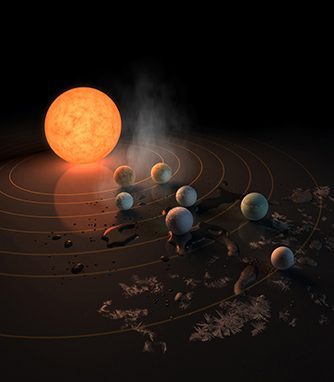Yesterday, NASA held a news briefing on the discovery of seven new planets orbiting a red dwarf star that’s just a “mere” 40 light years away from us.
At least three of the planets are in the habitable zone, meaning that they have the potential for liquid water.
You might remember the article that we wrote Is there Life Elsewhere in the Cosmos for the Strange Notions blog in 2015. The co-author of that article was University of Pennsylvania astrophysicist Marisa Cristina March. Dr. March does much of her research at Chile’s Cerro Tololo Observatory, which is about a four hour drive from La Silla Observatory where three planets were first observed orbiting the star in May 2016.

Astronomers using NASA’s Spitzer Space Telescope in conjunction with several ground telescopes not only confirmed the existence of two of these planets but discovered five additional ones.
In the 2015 article we looked at the possibility of life on planets outside of our solar system (i.e. exoplanets). Today’s announcement of multiple exoplanets located relatively close to us is exciting because it means that scientists will be able to potentially determine their atmospheric constituents and also whether any have liquid water on their surfaces.
Keep in mind that all of this is a far cry from discovering life “out there”, but the knowledge that there may be other planets capable of sustaining life is significant to how we view our place in the universe.
Furthermore, because we are just at the beginning of this exciting field of exploration, expect to hear much more about exoplanets over the coming years and decades.
Summary of NASA’s announcement:
- In May 2016 a Chilean based TRAPPIST (Transiting Planets and Planetesimals Small Telescope) team detects 3 earth sized planets orbiting a red dwarf star.
- Star is located 40 light years from earth (approx. 25 trillion miles).
- The planetary system is named TRAPPIST-1.
- NASA is confirming the presence of 2 of the original planets and 5 additional earth sized planets; three of which are within the habitable zone.
- The star is not nearly as hot as our sun and the orbits of all seven planets are closer to it than the orbit of Mercury is to our sun.
- Based on their densities, at least six of the seven TRAPPIST-1 planets are likely to be rocky.
- The planets are so close to one another that a person standing on the surface of one of them could gaze up and potentially see geological features or even clouds of their neighboring worlds.
Here at Magis, we’ll continue to keep you informed of discoveries and breakthroughs in physics, biology, neuroscience, and related fields that impact our understanding of God, creation, and the human person.
Have a blessed day!

